Related Research Articles

The Kickapoo people are an Algonquian-speaking Native American and Indigenous Mexican tribe, originating in the region south of the Great Lakes. Today, three federally recognized Kickapoo tribes are in the United States: the Kickapoo Tribe in Kansas, the Kickapoo Tribe of Oklahoma, and the Kickapoo Traditional Tribe of Texas. The Oklahoma and Texas bands are politically associated with each other. The Kickapoo in Kansas came from a relocation from southern Missouri in 1832 as a land exchange from their reserve there. Around 3,000 people are enrolled tribal members.
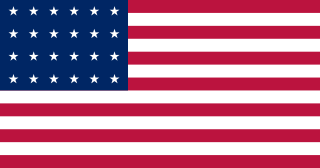
The Indian Territory and the Indian Territories are terms that generally described an evolving land area set aside by the United States Government for the relocation of Native Americans who held aboriginal title to their land as a sovereign independent state. In general, the tribes ceded land they occupied in exchange for land grants in 1803. The concept of an Indian Territory was an outcome of the US federal government's 18th- and 19th-century policy of Indian removal. After the American Civil War (1861–1865), the policy of the US government was one of assimilation.

The Miami are a Native American nation originally speaking one of the Algonquian languages. Among the peoples known as the Great Lakes tribes, they occupied territory that is now identified as North-central Indiana, southwest Michigan, and western Ohio. The Miami were historically made up of several prominent subgroups, including the Piankeshaw, Wea, Pepikokia, Kilatika, Mengakonkia, and Atchakangouen. In modern times, Miami is used more specifically to refer to the Atchakangouen. By 1846, most of the Miami had been forcefully displaced to Indian Territory. The Miami Tribe of Oklahoma are the federally recognized tribe of Miami Indians in the United States. The Miami Nation of Indiana, a nonprofit organization of descendants of Miamis who were exempted from removal, have unsuccessfully sought separate recognition.
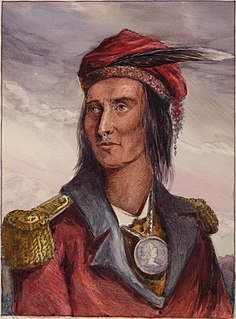
Tecumseh was a Shawnee chief and warrior who promoted resistance to the expansion of the United States onto Native American lands. A persuasive orator, Tecumseh traveled widely, forming a Native American confederacy and promoting intertribal unity. Even though his efforts to unite Native Americans ended with his death in the War of 1812, he became an iconic folk hero in American, Indigenous, and Canadian popular history.
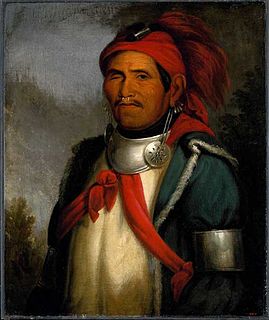
The Shawnee are an Algonquian-speaking indigenous people of the Northeastern Woodlands. In the 17th century they lived in Pennsylvania, and in the 18th century they were in Pennsylvania, Ohio, and Indiana with some bands in Kentucky and Alabama. By the 19th century, they were forcibly removed to Missouri, Kansas, Texas, and ultimately Indian Territory, which became Oklahoma under the 1830 Indian Removal Act.
Chalahgawtha was the name of one of the five divisions of the Shawnee, a Native American people, during the 18th century. It was also the name of the principal village of the division. The other four divisions were the Mekoche, Kispoko, Pekowi, and Hathawekela. Together these divisions formed the loose confederacy that was the Shawnee tribe.
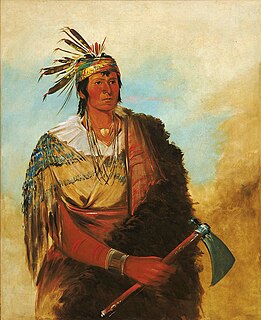
The Wea were a Miami-Illinois-speaking Native American tribe originally located in western Indiana. Historically, they were described as either being closely related to the Miami Tribe or a sub-tribe of Miami.

Indigenous peoples of the Northeastern Woodlands include Native American tribes and First Nation bands residing in or originating from a cultural area encompassing the northeastern and Midwest United States and southeastern Canada. It is part of a broader grouping known as the Eastern Woodlands. The Northeastern Woodlands is divided into three major areas: the Coastal, Saint Lawrence Lowlands, and Great Lakes-Riverine zones.
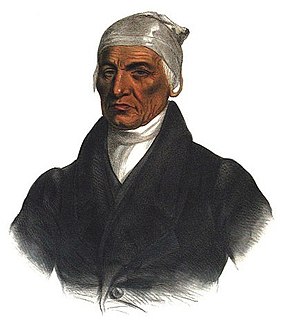
Mekoche was the name of one of the five divisions of the Shawnee, a Native American people, during the 18th century. The other four divisions were the Chalahgawtha, Kispoko, Pekowi, and Hathawekela. Together these divisions formed the loose confederacy that was the Shawnee tribe.
Pekowi was the name of one of the five divisions of the Shawnee, a Native American people, during the 18th century. The other four divisions were the Chalahgawtha, Mekoche, Kispoko, and Hathawekela. Together these divisions formed the loose confederacy that was the Shawnee tribe.
Hathawekela was one of the five divisions of the Shawnee, a Native American people during the 18th century. The other four divisions were the Chalahgawtha, Mekoche, Kispoko, and Pekowi. Together these divisions formed the loose confederacy that was the Shawnee tribe.
Snake was the English language name of two Shawnee leaders prominent in the history of the Ohio Country: Peteusha and Shemanetoo. They were both commonly referred to as "Snake" in historical records, or by variations such as "Black Snake" or "Captain Snake," so it is often difficult to determine which individual was being referred to. On a number of occasions, the two Snakes both signed a letter or appeared together, so it is clear they were two different people. There may have been additional Shawnees called "Snake," further complicating the matter. According to historian John Sugden, "it is unlikely if the biographies of these chiefs will ever be completely disentangled."

Indian removals in Indiana followed a series of the land cession treaties made between 1795 and 1846 that led to the removal of most of the native tribes from Indiana. Some of the removals occurred prior to 1830, but most took place between 1830 and 1846. The Lenape (Delaware), Piankashaw, Kickapoo, Wea, and Shawnee were removed in the 1820s and 1830s, but the Potawatomi and Miami removals in the 1830s and 1840s were more gradual and incomplete, and not all of Indiana's Native Americans voluntarily left the state. The most well-known resistance effort in Indiana was the forced removal of Chief Menominee and his Yellow River band of Potawatomi in what became known as the Potawatomi Trail of Death in 1838, in which 859 Potawatomi were removed to Kansas and at least forty died on the journey west. The Miami were the last to be removed from Indiana, but tribal leaders delayed the process until 1846. Many of the Miami were permitted to remain on land allotments guaranteed to them under the Treaty of St. Mary's (1818) and subsequent treaties.
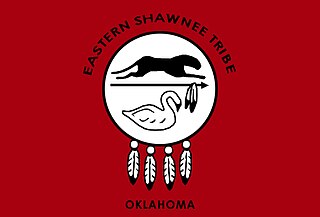
The Eastern Shawnee Tribe of Oklahoma is one of three federally recognized Shawnee tribes. They are located in Oklahoma and Missouri.

The Mingo people are an Iroquoian group of Native Americans, primarily Seneca and Cayuga, who migrated west from New York to the Ohio Country in the mid-18th century, and their descendants. Some Susquehannock survivors also joined them, and assimilated. Anglo-Americans called these migrants mingos, a corruption of mingwe, an Eastern Algonquian name for Iroquoian-language groups in general. The Mingo have also been called "Ohio Iroquois" and "Ohio Seneca".
On the eve of the American Civil War in 1861, a significant number of Indigenous peoples of the Americas had been relocated from the Southeastern United States to Indian Territory, west of the Mississippi. The inhabitants of the eastern part of the Indian Territory, the Five Civilized Tribes, were suzerain nations with established tribal governments, well established cultures, and legal systems that allowed for slavery. Before European Contact these tribes were generally matriarchial societies, with agriculture being the primary economic pursuit. The bulk of the tribes lived in towns with planned streets, residential and public areas. The people were ruled by complex hereditary chiefdoms of varying size and complexity with high levels of military organization.

Quatawapea or John Lewis, also known as Captain Lewis and Colonel Lewis and ‘’’Captain Johnny’’’, was a Shawnee leader for whom Lewistown, Ohio, is named. Lewis fought in the American Revolutionary War (1775–1783) and the Northwest Indian War (1785–1795) as part of Shawnee opposition to the expansion of the United States into Shawnee territory. After the 1795 Treaty of Greenville, he sought to preserve Shawnee autonomy by promoting accommodation with the U.S., working with Black Hoof, the principal Shawnee spokesman.
Kekewepelethy, also known as Captain Johnny, was the principal civil chief of the Shawnees in the Ohio Country during the Northwest Indian War (1786–1795). He first came to prominence during the American Revolutionary War (1775–1783), in which he, like most of his fellow Mekoche Shawnees, initially sought to remain neutral. He joined the war against the United States around 1780, moving to Wakatomika, a Shawnee town known for its militant defense of the Ohio Country.
References
- ↑ Lee Sulzman. "Shawnee History". First Nations Histories. Retrieved 2013-02-17.
- ↑ John E. Kleber (18 May 1992). The Kentucky Encyclopedia. University Press of Kentucky. p. 815. ISBN 978-0-8131-2883-2 . Retrieved 16 February 2013.
- ↑ "Peckuwe Shawnee Memorial Marker". HNdb.org, The Historical Marker Database. Retrieved 2013-02-17.
- ↑ Mark Howes. "Stage's Pond Local Lore". Stage's Pond State Nature Preserve. Archived from the original on 2013-12-08. Retrieved 2013-02-17.
- ↑ "Ohio Tribes". 500 Nations. Retrieved 2013-02-17.
- ↑ Harrison, R. H. (1880). Atlas of Allen County, Ohio from Records and Original Surveys, Philadelphia: R.H. Harrison. pp. 19.
- ↑ Roy, Jerry C. "A Shawnee Muster Roll: 334 Ohio of the Wapakoneta and Hog Creek Bands Emigrating to Kansas in 1832." (929/J63/v. 7/no. 2/p. 38). From: "American Indians in Kansas: a bibliography - Kansas Historical Society" . Retrieved 2013-02-17. "Provides census by individual tribes and names, in 1832. Interesting, with an excellent bibliography."
- ↑ "First director hired for Purdue's new Native American Educational and Cultural Center". Purdue University. 2007-08-23. Retrieved 2013-02-17.
- ↑ Susan O'Leary (2008-01-06). "Tribal groups call Indiana home: Commission spreading word on American Indian presence, needs". nwi.com. Munster, Indiana . Retrieved 2013-02-17.
- ↑ "Native American Tribes of Indiana". Archived from the original on 2012-08-10. Retrieved 2013-02-17.
- ↑ "Tribal Directory of Northeastern Indian Tribes". Indians.org. Retrieved 2013-02-17.
- ↑ "Shawnee". Four Directions Institute. Archived from the original on June 26, 2007. Retrieved 2013-02-17.
{{cite web}}: CS1 maint: unfit URL (link)